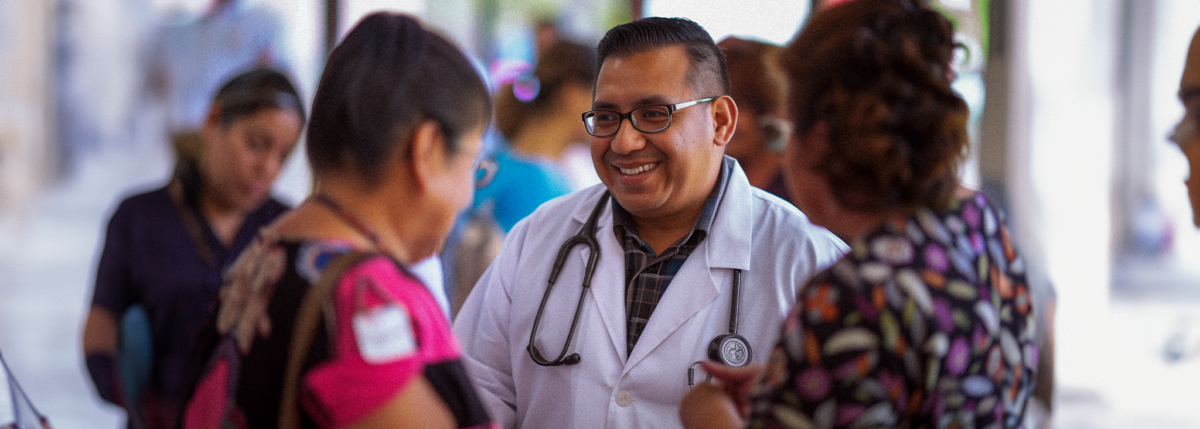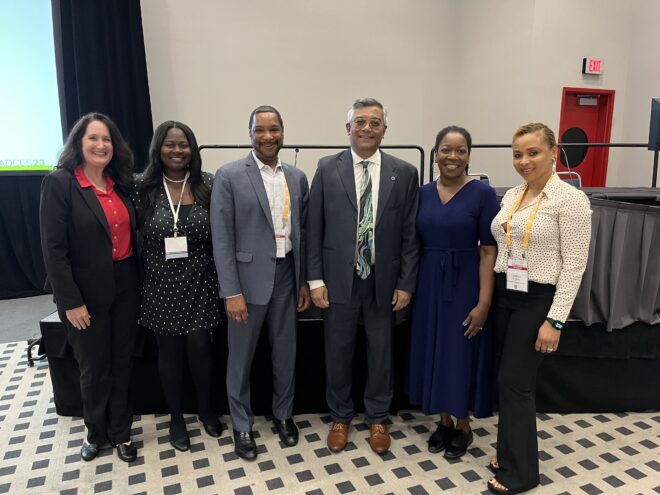Inclusive Health: Creating Access to Type 1 Diabetes Screening in Underserved Communities
Editor’s Note: This interview was condensed and edited for clarity.
Thanks to decades of research, it’s possible to identify type 1 diabetes (T1D) in its earliest stages and potentially delay the full onset, requiring daily insulin therapy.
Spotting those early stages, though, requires autoantibody screening. Screening looks for the autoantibodies that develop when the immune system attacks those insulin-producing cells. This autoimmune attack can start years before noticeable symptoms develop.
While screening itself is a simple blood test, the biggest challenge is educating people about the importance of getting screened and providing support for individuals who test positive for early-stage type 1 diabetes.
This effort is easier said than done, especially in underserved communities.
“We’re in the community——we don’t just sit here in the hospital,” said Franklin Hickey, PhD, RN, NEA-BC, chief of Staff of University Hospital, when asked about local screening efforts for T1D in Newark, New Jersey.
Research and outreach efforts to screen for T1D have made incredible strides to reduce the risk and severity of DKA (diabetic ketoacidosis) at the time of diagnosis. This outreach includes educating the general community about the symptoms of T1D, the earlier stages of T1D before symptoms develop, FDA-approved medications to delay the full onset of T1D, and ongoing prevention research. In partnership with JDRF’s early detection program, University Hospital in Newark, NJ, worked with JDRF to screen for type 1 diabetes and educate their community members about the signs and symptoms of T1D.
University Hospital plays a critical role in providing care to patients who are uninsured, qualify for Medicaid, and may be facing economic challenges, food insecurity, and housing insecurity. The hospital strives to address the health inequities that complicate a person’s ability to manage chronic conditions like diabetes.
Here’s a closer look at the partnership between University Hospital and JDRF, and their screening efforts.
The Power of Community Outreach
“Since the launch of this program in July of 2022, University Hospital has identified 1,000 individuals to be screened,” said Hickey. “To date, we’ve had 50 community events and screened 883 community members.”
The program offered screening to everyone—with an emphasis on children. Parents and caregivers were notified about the opportunity to have their children screened. Out of all of the patients they screened, 15 tested positive for T1D autoantibodies and two of those patients had two persistent diabetes-related autoantibodies. One child had an elevated hemoglobin A1C.
After a patient has been screened, University Hospital provides follow-up support and additional education based on the results. If a child tests positive for autoantibodies, University Hospital ensures they receive necessary support and guidance while getting connected to specialty care.
“We were able to find a pediatric endocrinologist and get that patient treated,” recalls Hickey. “We’re proud because that kid never had any issues with DKA. We prevented that from happening with our program.”
T1D screening and prevention may require educating individuals who’ve never heard of T1D and may only be familiar with type 2 diabetes (T2D), which is a metabolic condition.
“You don’t hear a lot about type 1 diabetes. Instead, most people in this community think of diabetes as type 2,” said Hickey. “When we’re calling these families of those kids that we identified with a diagnosis of T1D, we wanted to screen the parents and the siblings. But to do that, we had a script by JDRF explaining why this was important.”
Even if the screening results came back negative, participants were provided resources and education on the stages and symptoms of T1D.
University Hospital staff understand how much representation matters when sending people to educate the community about screening. The majority of the community members are African American and Latinx, and span nationalities including the Caribbean. This ensures they are reaching diverse communities to bring awareness to screening for T1D.
“We train our staff, including those who speak Spanish to spread our message to the Latino community,” said Hickey. “We even put a cultural liaison in our Portuguese community. We need people who understand these communities and cultural norms. That’s part of building trust.”
Addressing Socioeconomic Challenges Facing Community Members
Socioeconomic challenges can keep people from seeking preventative care, or any care at all, in a timely manner. Screening for T1D was no different—as some of the challenges people face include travel access, such as needing to take public transportation to get to the hospital. Understanding those challenges is why Hickey and his team meet people where they are and go directly into communities as much as possible.
Despite challenges, University Hospital maintains multiple touchpoints to ensure patients get test results and reminders for follow-up appointments.
“In addition to calls and emails, we use an electronic health record platform, where they can see their medical records, including test results, and send notifications about returning for another visit,” said Hickey.
Expanding T1D Screening to New Communities & Health Systems
Getting ahead of a potential T1D diagnosis is an all-hands-on-deck effort—it requires having adequate staff on hand and everyone from administrative staff to community healthcare workers, to primary care doctors to understand T1D, as it is a complex condition often conflated with type 2 diabetes.
The staff’s buy-in into the program is just as important as the community members who are at the receiving end. JDRF and University Hospital are learning what staff members need to be successful in interacting with program participants, especially as they consider its long- term future.
“We’re all learning in humility,” said Anastasia Albanese-O’Neill, PhD, APRN, CDCES, the AVP of Community Screening and Clinical Trial Education at JDRF. “We’re learning in partnership with Franklin and his team and incorporating those learnings into the next phase of this work. I think we’ve demonstrated feasibility and acceptability, but we want to know if this program is sustainable over time at University Hospital. We will work on answering those questions in the next phase of the partnership.”
JDRF and University Hospital are looking to replicate the success of this initiative with other healthcare professionals. Currently, they have over 30 pilot clinics across the country, ranging from federally qualified health centers to large health systems.
“We know healthcare professionals can go to a conference and learn about the importance of T1D screening, but they may not implement it when they return to work,” said Albanese-O’Neill.
“This initiative is proximate to care and community education. Trust is critical. That’s why we supported University Hospital to hire a full-time T1D navigator who is working to build relationships in the community. These partnerships are essential in identifying and prioritizing the needs of the community.”
How the T1D Community Can Support Early Detection of T1D
The T1D online community has been a beacon of support for many who are newly diagnosed. People impacted by this chronic condition often use their platforms to educate others about managing diabetes, as well as the signs to look for in others. JDRF has a dedicated community of volunteers who spread awareness about the organization’s initiatives.
By joining forces, University Hospital and JDRF have successfully broadened their ability to reach more diverse communities.
Hickey also emphasized the importance of volunteers helping to spread the word about screening, especially within underserved communities.
Albanese-O’Neill agreed, adding that JDRF volunteers play an important role in spreading the word about this initiative.
“It’s important for our volunteers and the T1D community to know that these screening programs exist. They can be our allies in finding more clinical champions and connecting people back to our work at University Hospital.”
This article was made possible due to the JDRF x Beyond Type 1 Alliance. For more resources on screening for type 1 diabetes, please visit JDRF’s T1Detect website and Beyond Type 1’s resources. To become a JDRF volunteer, please click here.






